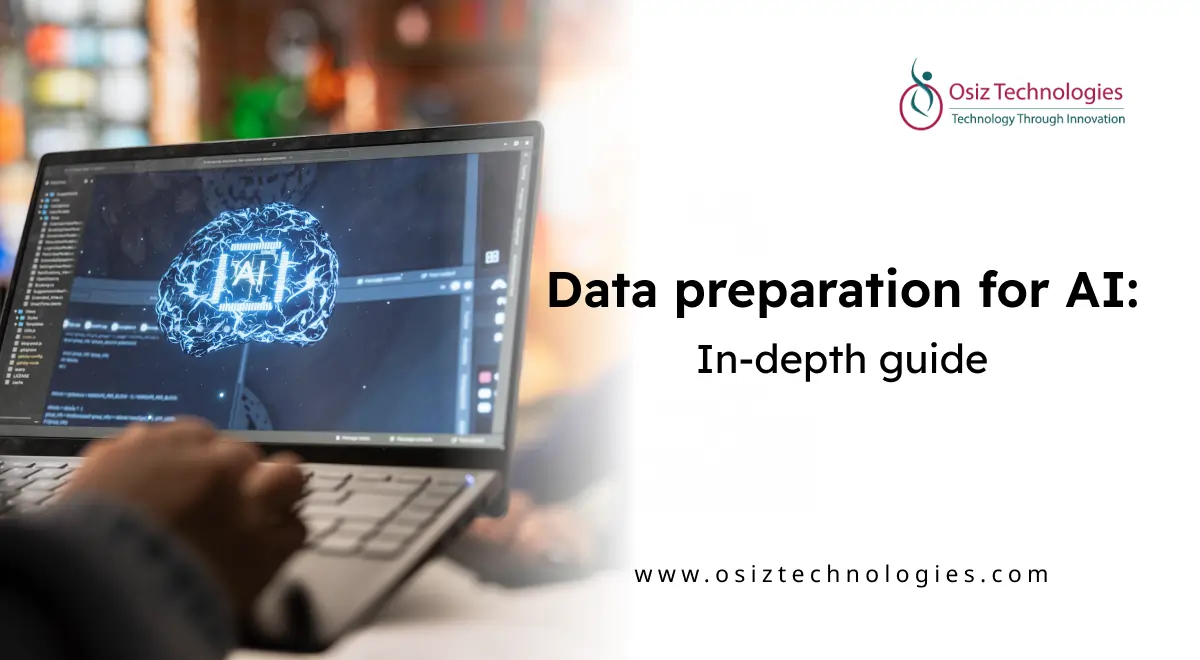Embracing machine learning has become imperative across industries, evident in the diverse applications of AI models. In this article, let’s learn in depth about machine learning, the development process, business benefits, and the cost of developing machine learning.
What is Machine Learning?
Machine learning is a subset of artificial intelligence (AI) that focuses on developing systems and algorithms that allow computers to learn from data and make decisions without explicit programming. At its core, the essence of machine learning lies in the ability of machines used to recognize trends, identify patterns, and adapt their behavior based on experiences.
The learning process in machine learning involves exposing the system to vast amounts of data, enabling it to generalize and make predictions or decisions without being explicitly programmed for every scenario.
Types of Machine Learning
There are various types of machine learning, including supervised learning, unsupervised learning, Semi supervised and reinforcement learning, each serving distinct purposes in training models.
Supervised learning involves training a model with labeled data, where the algorithm learns to map input data to corresponding output. Unsupervised learning deals with unlabeled data, allowing the algorithm to discover patterns and relationships within the information. Semi-supervised machine learning combines labeled and unlabeled data for improved model training, addressing challenges in acquiring extensive labeled datasets. Reinforcement learning entails instructing a model to make a series of decisions through the receipt of feedback in the form of rewards or penalties.
Machine learning finds applications across diverse domains, from natural language processing and image recognition to predictive analytics and autonomous systems. The continuous evolution of machine learning algorithms and techniques contributes to its pervasive influence, transforming how we approach problem-solving and decision-making in the digital age.
How to Build an Innovative Machine Learning App?
The development process of machine learning are as follows:
-
Assessment Phase: Clearly outline the goals and functionalities your machine learning app should achieve, ensuring a focused development process.
-
Quality Data Collection: Gather relevant and diverse datasets for training, ensuring they accurately represent the real-world scenarios your app will encounter.
-
Algorithm Selection: Choose appropriate machine learning algorithms based on your app's objectives and the nature of the data, optimizing for accuracy and efficiency.
-
Model Training and Optimization: Train your model with the collected data, continuously refining and optimizing it to enhance performance and accuracy.
-
User-Friendly Interface: Design an intuitive and user-friendly interface that enhances the user experience, making it easy for users to interact with the machine learning features seamlessly.
-
Seamless Integration: Ensure smooth integration of machine learning capabilities into your app, maintaining a cohesive user experience and avoiding disruptions in functionality.
-
Continuous Improvement: Implement mechanisms for ongoing monitoring, feedback collection, and model updates, ensuring your machine learning app evolves to meet changing requirements and user needs.
Business Benefits Via Machine Learning
-
Enhanced Decision-Making: Machine learning empowers businesses to make data-driven decisions swiftly, leveraging insights derived from complex datasets for more informed and strategic choices.
-
Operational Efficiency: Automation of repetitive tasks and processes streamlines operations, leading to increased efficiency and productivity, allowing employees to focus on higher-value tasks.
-
Personalized Customer Experiences: Machine learning enables businesses to analyze customer behavior, preferences, and interactions, facilitating the delivery of personalized products, services, and recommendations.
-
Predictive Analytics: Anticipating trends and potential issues through machine learning models allows businesses to proactively address challenges, adapt strategies, and stay ahead in a dynamic market.
-
Cost Savings: Automation and optimization brought about by machine learning lead to cost reductions, from streamlined processes to improved resource allocation, contributing to overall financial efficiency.
-
Competitive Advantage: Businesses adopting machine learning gain a competitive edge by staying abreast of technological innovations, adapting quickly to market changes, and continuously improving their operations.
Industries Benefiting Via Machine Learning
Healthcare
Machine learning in the healthcare sector is mainly used for Disease diagnosis, personalized medicine, predictive analytics for patient outcomes. This helps to detect early disease, Improved patient care, optimized treatment plans.
Finance
In the finance sector, machine learning is used for Fraud detection, credit scoring, algorithmic trading, and risk management. By utilizing machine learning in finance operations it enhances security, efficient financial operations, and better risk assessment.
Retail
In the retail sector, machine learning is used in the following operations:
-
Demand forecasting
-
personalized recommendations
-
inventory management
By implementing machine learning, it improves customer experiences, optimizes the supply chain, and increases sales.
Manufacturing
Machine learning in manufacturing industries is used for predictive maintenance, quality control, and supply chain optimization. The advantages of using ML include reduced downtime, enhanced product quality, and efficient production.
Marketing and Advertising
Machine learning is also used in marketing and advertising for targeted advertising, customer segmentation, and sentiment analysis. This benefits and enhances marketing effectiveness, personalized campaigns, and customer engagement.
Some Notable AI Model
GPT-4: GPT-4 is designed to tackle intricate problems by leveraging advanced reasoning and possessing extensive general knowledge, making it a go-to solution for high-accuracy problem-solving.
PaLM 2: Google's PaLM 2 emerges as a cutting-edge language model adept at handling complex reasoning tasks and demonstrating proficiency in multiple languages, making it invaluable for tasks such as code interpretation, mathematical solutions, translation, and categorization.
LLaMA (Large Language Model Meta AI): LLaMA stands as a foundational model excelling in various language tasks, from text generation to complex problem-solving, making it an ideal choice for conversational AI, math theorem solving, and protein structure prediction.
Claude: Developed by Anthropic, Claude serves as a large language model seamlessly integrated into business workflows, functioning as a virtual assistant for a wide range of conversational and text-processing tasks.
DALL·E: OpenAI's DALL·E introduces a novel approach to image generation, creating realistic images and artwork based on text prompts, allowing for applications in realistic image creation and modification.
Whisper: Whisper, an OpenAI general-purpose speech recognition model, excels in language identification, speech translation, and multilingual speech recognition, offering advancements in auditory data processing.
GPT-3: OpenAI's GPT-3 is a powerful language model renowned for its natural language processing capabilities, finding application in text generation, summarization, translation, and question answering.
Moderation Models: Specifically designed for content moderation tasks, OpenAI's moderation models contribute to identifying and removing inappropriate content from online platforms, ensuring a safer online environment.
Stable Diffusion: Stable Diffusion, with its capability to generate detailed images from text prompts, finds applications in tasks like inpainting, outpainting, and image-to-image translations guided by text.
Embeddings: OpenAI's Embeddings provide numerical representations capturing semantic meaning and relationships between linguistic units, facilitating tasks like semantic analysis and language understanding.
Bard: Google's Bard, powered by LaMDA, operates as a text-to-text generative AI chatbot, delivering human-like responses in natural language conversations, demonstrating advancements in conversational AI.
Understanding the Cost of Machine Learning App Development
The development cost for a machine learning app typically falls within the range of $50,000 to $300,000. Several factors contribute to the overall expense, necessitating a detailed exploration of their impact on the project budget. Let’s get to know the factors influencing the cost to build a machine-learning app:
-
Complexity of App
-
Availability of Data
-
Selection of Required Algorithm
-
Model Training
-
Quality of Data
-
Existing System Integration
-
Licensing and Data Costs
-
App Development Company Location
-
Features Integration
Machine learning is reshaping industries and unlocking unprecedented possibilities. Building an innovative machine learning app requires strategic planning and collaboration with a skilled development team. The benefits for businesses are substantial, spanning increased efficiency, better decision-making, and enhanced customer experiences. Industries across the board are embracing machine learning, and examples of AI models showcase the diversity of applications.
Osiz Technologies stands out as a premier AI development company, With a proven track record of delivering innovative solutions, Osiz combines technical expertise with a client-centric approach. The team at Osiz excels in data-driven decision-making, employing state-of-the-art algorithms to craft robust machine learning models. Their commitment to quality, adherence to deadlines, and post-launch support make them a reliable partner in turning machine learning concepts into reality.
Listen To The Article
Recent Blogs

X-Mas 30%
Offer












